How to Effectively Plan for a Group Move
A White Paper on how to successfully plan, execute and survive your Company's next group move
Imagine that you are just leaving a meeting where you were told that your employer has decided to relocate a group of people from one location to another. The CEO told you that you are expected to manage the move. He/she stresses to you that the success of this group move is critical to the future of the Company and everyone is counting on you to “make it happen.” Any number of business scenarios could lead to this decision.
Even though this may be your first experience in managing a group move, you may have heard stories about the stress group moves can bring to an organization and the people who are working on it. You may recall hearing how a group move does not always turn out as planned, and that a lot can change from when the plan is initiated until the last employee is in place at the new location. There will always be times when no matter what actions are taken, it will not alter the end result.
Whatever you do, you need to be prepared for the possibility of:
- Business disruption
- Talent loss
- Low employee morale
- Cost overruns
- Having your plan for the move challenged by others
You may not be able to eliminate all of the issues, but if you can bring an effective plan to the project, as well as assemble the right team to execute the plan, the odds that the move will be a success and that you will survive the group move will be greatly improved. The intent of this paper is to provide you with a proven approach to effective group move management.
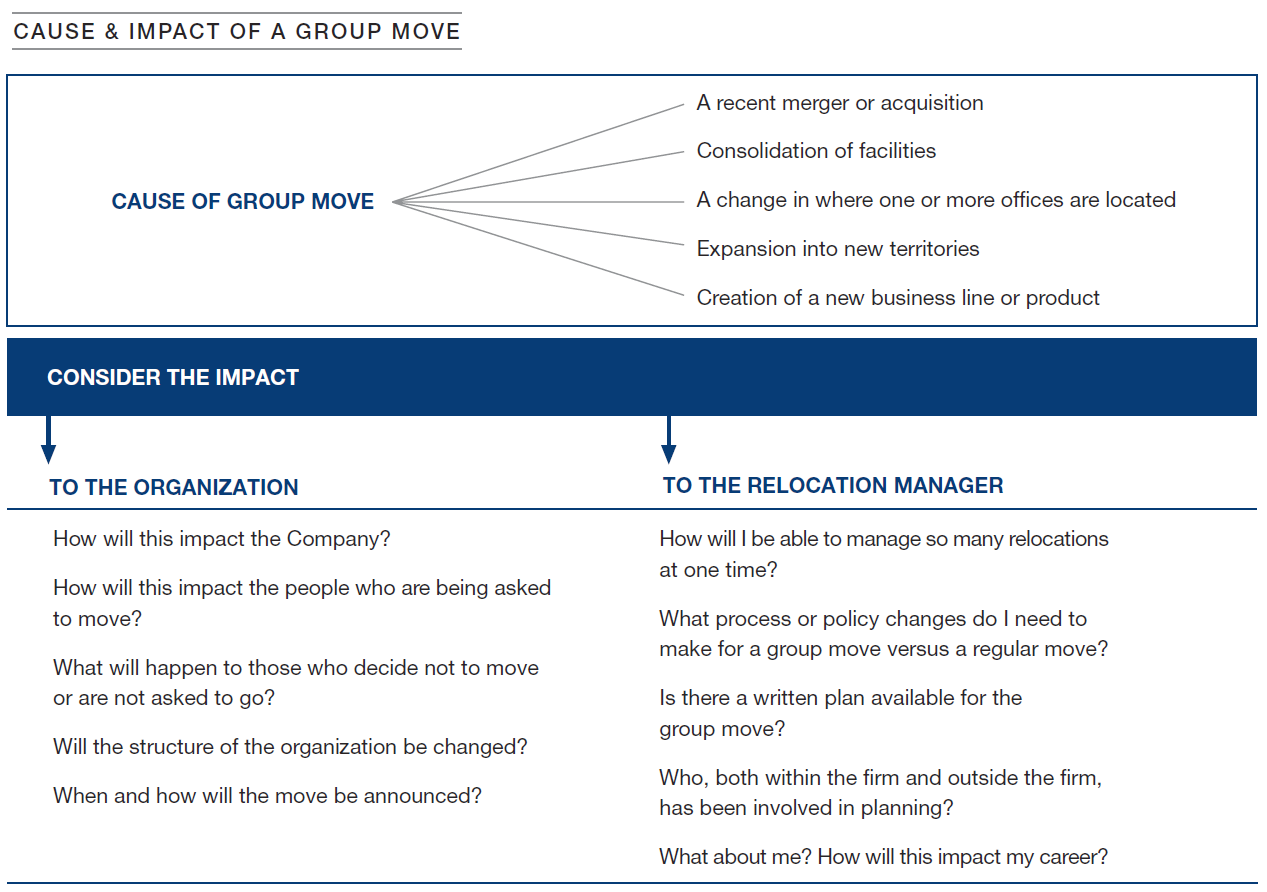
What is a group move?
The definition of a group move is when 10 or more employees are being transferred from the same area and to the same area, at the same time, for the same business reason. Group moves are extremely critical to the performance of the Company and of a high strategic value in meeting the objectives of the business plan. If the group move is being driven by either a merger or an acquisition, the pressures only become greater as the already charged environment that a group move can create, is compounded with the added factors of merging two different cultures. This reality, combined with the inherent risks that a merger or acquisition almost always adds, results in higher stakes and more pressure on relocation professionals to make sure that the right group move process be in place.
Short distance group moves
It is not uncommon for companies to change office locations (or have multiple facilities in the same geographical area) with the distance between an employee's old and new work location either meeting or not meeting the IRS 50-mile test.
When creating a relocation policy for a short distance group move, you will need to address a number of issues such as:
- Determining the distance between the old and the new work locations and the number of employees who are impacted.
- If the IRS 50-mile test is not met, you must decide if you will provide any relocation assistance.
- If the IRS 50-mile test is not met and you provide relocation assistance, you must decide which relocation features should be provided.
Why do group moves fail?
In a series of internal interviews with subject matter experts, who have had extensive experience assisting our clients in planning and managing a wide range of corporate group moves, a number of reasons repeatedly rose to the top as to why a group move may fail:
- Announcing the move without adequate preparation or involvement
- Not having clearly defined objectives
- Lack of time and/or poor planning
- Losing control of the transferees
- Not understanding the unique needs and dynamics of the group
- Not bringing outside resources in early enough
- Political pressure to use non-qualified suppliers
- Lack of senior management endorsement and involvement
Steps for Employee Buy-In and Increased Productivity
| Thorough situation analysis | The analysis will cover the business case leading up to the move. The goal is to develop a single reference document that establishes the foundation for the move and lays out all of the salient facts surrounding the event. |
| Effective policy review | Having the right policy in place tailored specifically for the group move is crucial. Conduct a “gap analysis” starting with your current relocation benefits and then either add or subtract benefits based on your business and policy objectives. |
| Targeted program communications | Develop clear, concise and strategic channels for communicating the entire program with a focus on the identified needs and profile of your audience. |
| Pragmatic buying-and-selling workshops | Increase the success of the move by conducting well-thoughtout workshops that set realistic expectations, contain educational materials that are easy to use and are facilitated by highly qualified instructors. |
| Expert consulting services | No matter what the size or complexity of the group move, attempting to go it alone without the ability to draw upon resources can be difficult and risky. Increase the opportunity for success and arrange for access to experienced resources that have the expertise in all aspects of group move management. |
How do you avoid the pitfalls?
Define the where and why
The strategic need for a group move is not one that is made easily. It is assumed that careful consideration was given in choosing the new site. In most cases, there is no choice on where the group will be asked to move as your Company may already have a pre-existing facility that fits the business need. If the Company did have a choice, it is critical that a sound and well-thought-out process has been followed and that a number of sites have been evaluated. It is critical that people with the skills and tools have given proper consideration to the quality of life, cultural issues, labor force, cost-of-living differences, housing availability and commuting times, as well as the business rationale for the move.
One of the first thoughts that will go through candidates’ minds is, what does the new location have to offer compared to where they are living now? In a group move, this evaluation is clearly magnified as co-workers talk, speculate and share concerns. You will need to be prepared with a clear rationale for why the new location was selected and have a communication plan prepared to explain the decision.
A critical component of any group move is to be able to tie the reason back to a sound business objective— perhaps it is to improve efficiencies, occupy a less costly facility, provide less expensive housing choices for employees or be closer to the Company's market and/or customer. Whatever the reason, even if there are underlying factors that you are unable to openly share, be prepared with a clearly stated goal that you can define and defend.
Get started early
It is most helpful if you are recognized as a resource who should be brought into the decision-making process early. It may not always happen, but the sooner you can begin planning the move, the better.
Too often people underestimate the complexity of a group move and the critical need to have the time to properly prepare for the move prior to it being announced. Making the announcement of the move prematurely can be very damaging and have a negative impact on your ability to manage it effectively. Depending on the complexity and size of the group move, pre-announcement planning may require more time than originally intended. Make every effort to allow enough time to plan effectively and to anticipate what the concerns and the questions will be.
Pre-announcement activities
Identify the resources you will need. Consider all the internal departments that need to be involved or will be impacted by the move. Evaluate if you need to bring in outside resources to assist you in managing the move. Who should be on the team may not always be obvious.
It may be that there is a “working team” and a “guidance review team.” Having a “team within a team” is a more efficient way of not having to have everyone at all the meetings and remain focused while still having the resources available.
Once your team or teams are selected, it is time to build your plan. The following steps can help you get started.
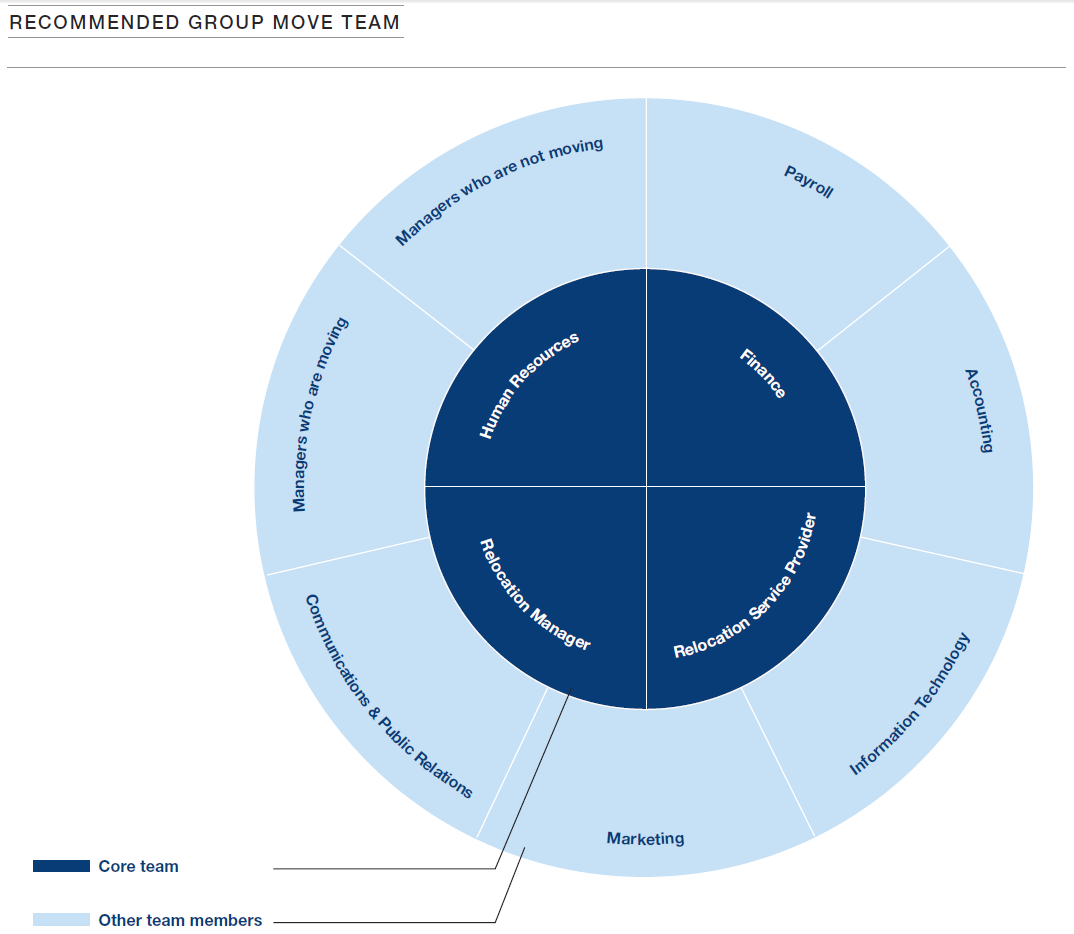
Create a timeline for the move. If possible, have your leadership team provide you with a “hard date” as to when they want the move to be completed. Test the logic behind the date. Is it feasible? Will the building be ready to occupy? Will the timing of the move disrupt business during peak months? Can everyone be moved by the date? Remember, once you agree on a date (whether you had input or not) you will be measured on whether or not you hit the date. If it is not possible to establish a specific date, you will need to recognize that you are working against a moving target that will add complexity to the timing of the move as well as be a source of stress and anxiety for the people moving. In addition, group moves without a hard end date complicate the entire process, as it implies there is always “more time.” Determine your schedule for accomplishing each element of the project outlined below:
You will also want to establish the timetable for acceptance once employees are invited.
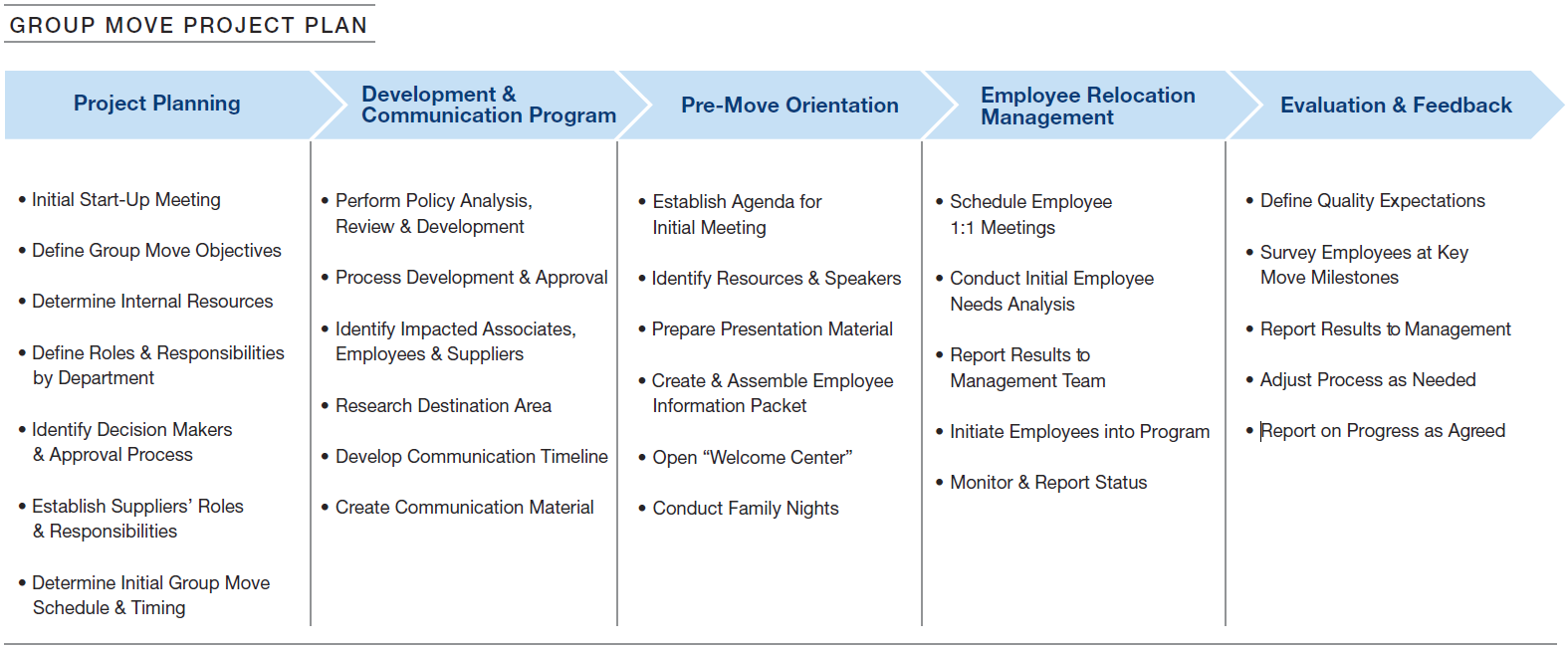
Gather data on the people who will be impacted by the move. This will include both those who are moving as well as those who are not. For those who are moving, you need to gather a great deal of data, which includes:
- Current position
- Tenure with the Company
- New position
- Current salary
- New salary
- Current manager
- New manager
- Family information
- Homeowner or renter information
- Current address
- Expected move date
For those employees who are moving, as well as those employees who are not going to move, you or someone on the team need to have the answers to a number of critical questions such as:
Review your current relocation policy to evaluate whether it will support the objectives of the move. There are a number of factors to consider first. Do you want everyone to make the move or not? If the answer is “yes,” then your policy may need to be enhanced. Will you need to offer an incentive to encourage people to move? What are the differences between the old and the new location? Will those differences require additional benefits such as increased temporary housing coverage due to the lack of housing and the expectation that a number of people will purchase new construction? Perhaps your Company is moving from a major metropolitan area to a suburban location, and you expect that a portion of the group will need to purchase cars and may even need driving lessons! Conversely, if the Company does not want everyone to make the move (i.e. there is an employee surplus), then it is not uncommon for relocation benefits to be reduced from those offered for regular transfers.
If a large number of people are being relocated over an extended timeframe, you will need to decide if you will protect those who are moving at the end of the group move timeframe. While not a factor in most areas, in small towns by the time they start the process, the group move may have negatively impacted the value of their home. Will you provide employees with some protection against a downturn in the market caused by the group move? This is just one example of where a thorough policy review is an essential step in preparing for a group move.
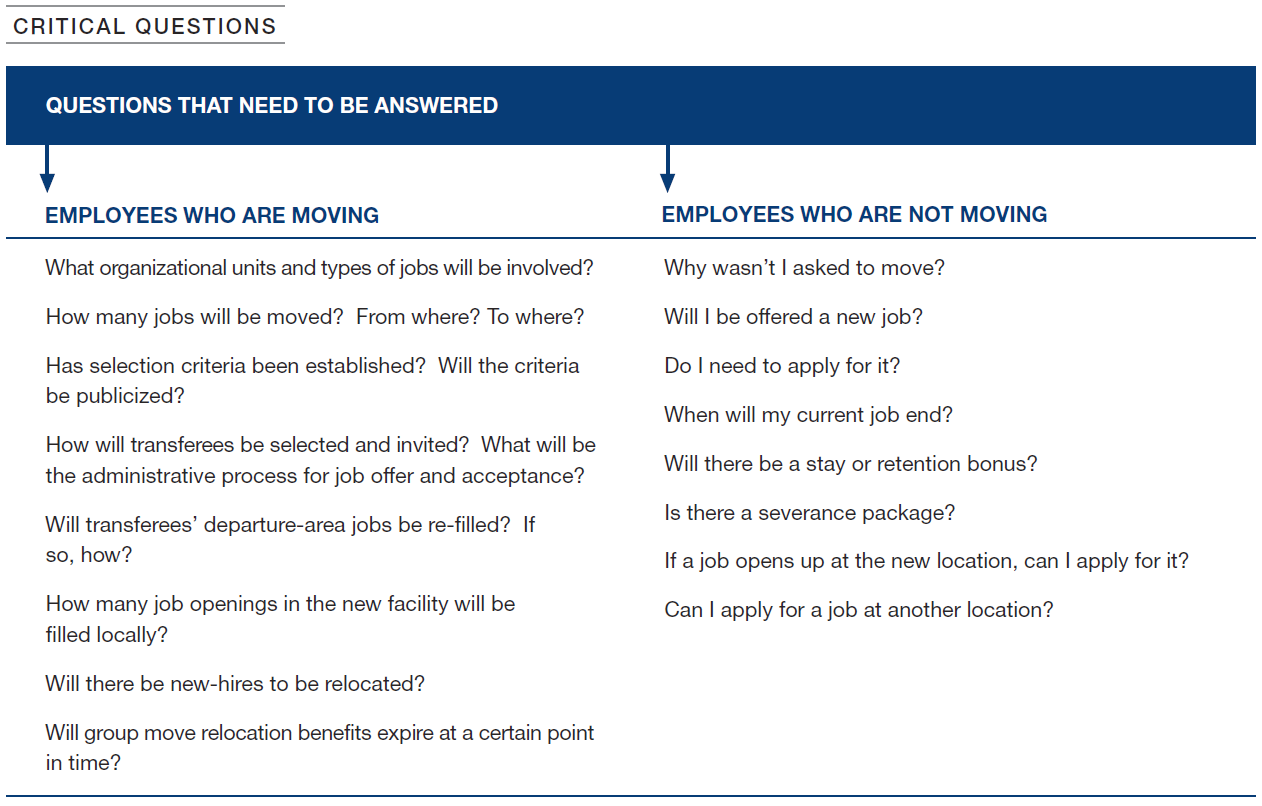
Conduct an employee survey. A properly designed survey will reveal a great deal of information regarding how your employees are viewing the potential move and what they feel they need in a policy to support their taking the move. In preparing the survey, it is recommended that you do not ask a question about a potential need if you already know that your answer will be “no.” For example, if you have ruled out offering spousal assistance, do not ask questions about how important it is to them in making the move that their spouse finds a job in the new location.
It is always wise to allow for a degree of flexibility in the administration of policy. If your policy does not allow children to go on a home finding trip, but you reimburse childcare—be flexible and allow the employee to apply the childcare coverage toward the cost of taking a child on a home finding trip. Create a “Frequently Asked Questions” (FAQ) document, and explain the procedure for trading benefits (if you allow it). By providing a clear explanation, you will reduce employee stress and make your job easier, because you will have answered the questions asked in advance. If it is not possible to conduct a survey, design a detailed needs analysis to be used during one-on-one counseling sessions with employees and families. This will provide you with the opportunity to learn more about each situation and hopefully adjust the group move policy early in the process to better meet the needs of the transferees.
Arrange a market study of both the old and new locations performed by yourself or a firm that provides this expertise. This study should include fieldwork at both locations. The accuracy of these studies will be crucial to the formation of your budget and policy for the move. You must accurately estimate the cost and availability of housing. The home value in the new location will drive many of your expense buckets. If you simply estimate home value based on your current relocation history, you have the potential of missing budget targets and impacting the success of the move. For example, if your national home value average is $250,000, and you are moving people from a high-cost area or the group is upper-level employees, the actual home values could easily increase to over $350,000. If you are moving 100 people and paid a 6 percent real estate commission, this would equate to a $600,000 overrun on just this one line item. It would also impact your estimated reimbursement for new home closing costs, as well as other significant line items. Additionally, your relocation service provider can use the housing information to estimate the potential costs of other key cost drivers, such as the transportation of household goods or corporate housing. It is wise to conduct a thorough cost study and resist the inclination to move fast and bypass this step.
Build a preliminary budget. Find out how much money has been budgeted to achieve the group move objectives, how the cost projections were developed, and what assumptions were used. The magnitude of the move and the policy components will determine the level of detail the budget will include. Some typical line items include:
- Compensation
- Homeowner or renter
- Family status
- Policy type
- Amended value ratio (inventory homes)
- Home value (current home)
- Home finding expense
- Estimated new home value
- New home purchase closing cost
- Duplicate housing
- Temporary housing
- Visits home during temporary housing
- Movement of household goods
- Storage
- Miscellaneous allowance
- Gross-up expense
- Exceptions
Your final policy components will drive what you ultimately track. Keep a separate budget that includes the costs of bus tours, extra travel, special events, as well as separation, severance and stay/retention bonus expenses. An important part of the budgeting process will be not only to project the cost, but also to project when you expect those costs to occur. Group move costs can create a spike, as they typically take place at the same time and can have a dramatic impact on quarterly or yearly reporting. In order to make the budgeting process as easy as possible, look for costs that can be fixed to decrease the variability of your numbers. Remember to keep your finance team advised of any changes in the timing of the move.
Finalize your relocation policy and present it to your management team. The policy presentation should have a solid rationale supporting what benefits you recommend to offer and how they tie to the group move objective and business goals. Revise your budget to reflect final policy. In these presentations, it is best to use ranges in costs rather than one set of numbers.
Develop a communication plan. This is a key step prior to announcing the move. Work with your team to create a plan for transferees, management and suppliers. Develop a FAQ document that covers what should and should not be said by those who will administer the group move. It is important to have in place the process and procedures that will be followed during the administration of the relocation. Assemble a manual of all the material you feel the different groups will need ahead of time so they have one consistent resource as a reference.
During the move
The first day of a group move can be overwhelming to both your team and to those who are hearing the news for the first time. Hopefully you have been able to keep the announcement confidential. No matter how you and the team may personally feel about the move, it is critical that you project a sense of excitement and confidence, and demonstrate a positive attitude on this first day and until the move is over. You will not be provided a second chance to make a good first and lasting impression, so make sure that the entire management team is on board, prepared and ready to go.
Making the announcement
Prior to making the announcement, assign responsibility for key events and create a timeline for the day. This includes finding space, bringing in food, creating materials, planning the day’s agenda and, most important of all, prepping the senior leader on what to say and what not to say or promise. Recommend that he or she stay through the entire event, as the group will be watching for any sign that can be interpreted as a lack of interest or commitment to the move. This day is all about conveying the right message. Be careful in choosing the space and setting the right tone of the announcement. If the space is unappealing, uncomfortable or poorly prepared, it will have a negative impact on the group. An announcement should cover the reason(s) for the move, when it will happen and why the new location was selected. Be honest and do not oversell the new location, but at the same time do not apologize for the decision that has been made. This will set the stage for the employees’ attitude toward the move.
This meeting should be for employees only (no spouses). The meeting is for the Company to outline its objectives, relocation policy and benefits.
The presentation needs to be completed within one hour to one and a half hours, including the question and answer portion. Try to target attendance at a maximum of 50 employees per session.
After making the announcement, review the agenda and the timing of the move. Prepare an “employee packet” that will be distributed at the meeting. The packet’s contents will vary, but usually contains:
- An agenda
- Schedule of events
- Copy of the announcement
- Material of the new location
- Relocation policy highlights and a relocation policy
- Travel and expense reimbursement policy
- Key contact information
- FAQ document
During the day, look for signs of information overload. This is where the development of a well-thought-out FAQ document will help. Develop your FAQ by asking your team to submit questions and work together to develop the answers. This will allow you to cast a wide net for possible questions, as well as draw upon the expertise of the group to provide well-crafted answers.
Provide a facility or an off-site meeting room for immediate use after the orientation meeting. This site will be used to meet with employees to address their concerns and needs. The Company’s interest in and support of the entire move will be conveyed at a very personal level through the understanding, knowledge and attention demonstrated by the on-site counseling, reducing complaints and rumors. In addition, early understanding by the Company of sensitive and/or problem issues will allow the Company time to address and to manage them before they create either negative perceptions of the Company or resistance to the move.
Pre-decision
To be successful, you need to provide employees with high-quality factual information in order for them to make an educated and informed decision about whether or not to make the move. Typically information and evaluation activities are divided between the old and new locations.
Allow time to regroup at the end of the day to review how the day went and take the time to go over any individual employee issues that occurred that day. Document (in writing) all issues and how they were resolved for future reference. Add appropriate issues to the FAQ document.
After the announcement is made, provide employees with access to a Relocation Center (resource room) to help them make their decision. In many companies, this decision period is very short (48 hours is not uncommon) and is required in order to move on to the next candidate. Collect as much information about the new location that you can. Provide PCs with links to favorite sites and load with the information you have provided in the employee packets. If possible, set times both during the workday as well as after hours when someone will be in the room to be available for Q&A. Consider providing pre-decision counseling via a toll-free number. Your employees will then have one central place to go to get their questions answered that are not in the FAQ document.
A nice touch is to have a welcome package in the employee’s hotel room with a gift and a “thank you” note from the senior leader of the team. This will provide an increased acceptance/support of the move on the part of the employee, with higher productivity pre- and post-move. It also creates positive morale toward the Company’s strategic plan of having more satisfied, well-adjusted transferees and families.
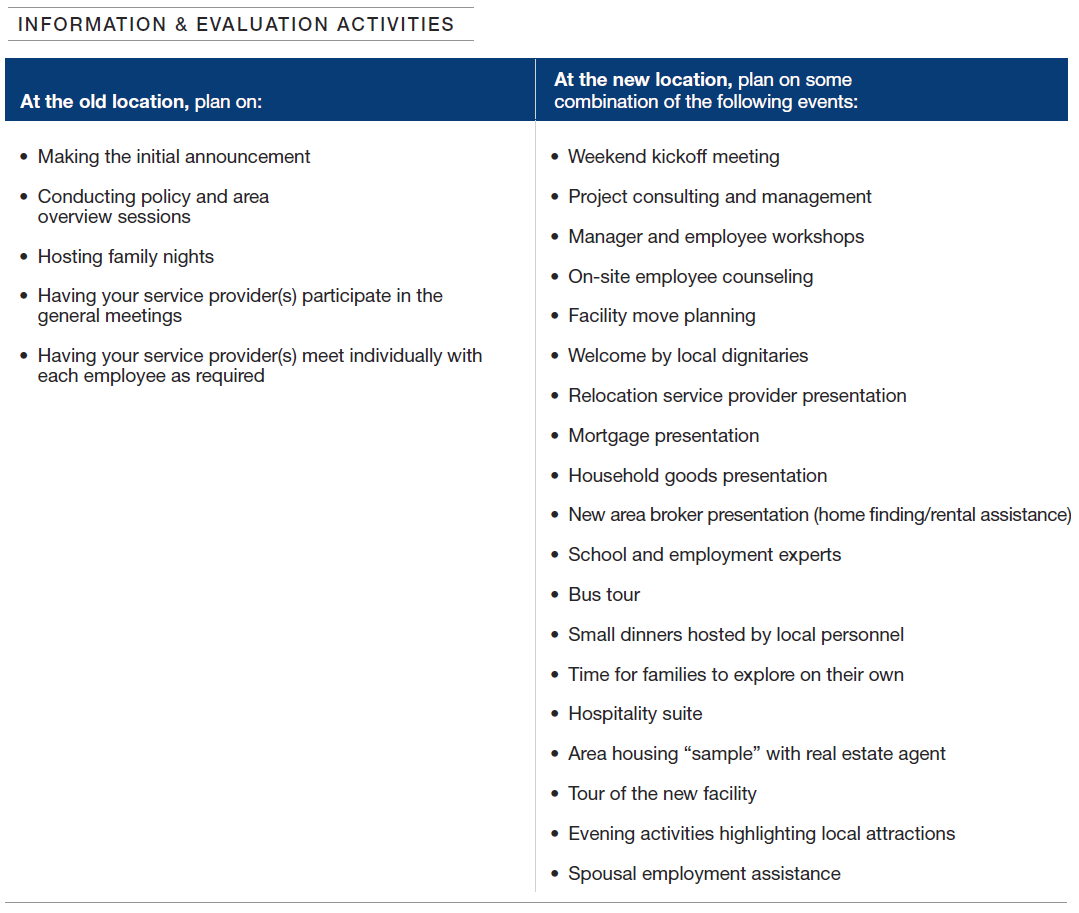
What are the keys to managing the move?
A project manager should be assigned for the duration of the entire move. After you have moved past the announcement and area visits, the need to focus on the process and logistics of the move takes precedence. To do this effectively, you need to establish procedures for a number of key events and process points. The first is determining which employees will accept or reject the move. Provide the employees with a fair and reasonable amount of time to make their decisions if this is the timing plan. Placing pressure too quickly or allowing too much time to decide can lead to problems. Once an employee has agreed to relocate, require a signed payback agreement or a letter of intent to move before you commit to any additional expenses. Other keys to managing the move include:
Create a well-thought-out exception management process. In order to have key personnel accept the move, you may need to be flexible and grant reasonable exceptions. Decide in advance where you will consider making exceptions to policy and the approach you will take. You will want to be consistent and treat each request fairly to avoid rumors or negative feelings that could lead to dissatisfaction and low morale.
Develop a process to respond to questions as the move progresses. Consider setting up a mailbox for questions and committing to providing answers by every Friday or Monday. Add these additions to the FAQ document.
Create solid controls to limit the number of people acting outside of the program, as the timing of the move can lead to people getting ahead of the process. Creating solid controls will also avoid incurring extra costs. For example, someone may purchase a home too early at the new location and then need reimbursement of duplicate housing payments that add unnecessary cost to the move. Select qualified suppliers and train them, in advance, on the policy to place solid controls in the field and limit the likelihood of members of the group making bad decisions. At times there may be political pressure to use a specific supplier. If the supplier is qualified, there should not be a problem. Avoid using suppliers that do not have the capacity and financial capability to provide you with the breadth of service required to effectively manage the move.
Keep your customers and suppliers informed to reduce any anxiety concerning business continuity. Prepare a separate communication piece targeted specifically toward each group. Follow it up at regular intervals as the move proceeds. An essential part of the planning process is to have contingency plans to maintain ongoing operations. Depending on your business structure, you may have the option to shift work to another facility, bring in staff from another location, hire temporary or contract employees, arrange for contingency staffing from your suppliers or negotiate “stay bonuses” with employees who are not moving, but have skills you need to rely on until the business is up and running at the new location.
Who should assist in managing a group move from outside the Company?
Assembling a team with prior group move experience will bring immediate credibility to the move. Most organizations will not have all of these skills in-house and will need to outsource to a supplier that can find all of the other resources needed.
What should you look for in a supplier?
Group moves are complex events that require a unique combination of skills and experience. Look for skills such as:
- Project management
- Relocation policy development
- Dealing with people under stress
- Previous group move experience
- Policy counseling
- Process development and management
- Supplier selection and management
- Understanding real estate markets
- Cost control
- Reporting process in regard to service use, satisfaction and costs


